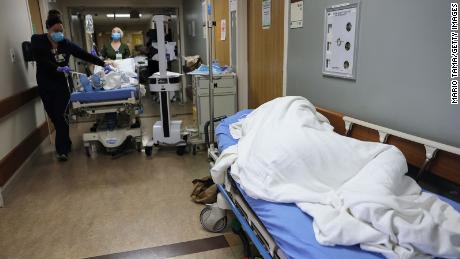(CNN)Oxygen supply issues led at least five Los Angeles County hospitals to declare an "internal disaster" Sunday, which included turning patients away.
There are multiple issues involving oxygen delivery to patients, but generally the problem is not an absolute shortage of oxygen, according to Dr. Christina Ghaly, Los Angeles County Health Services director.
Instead, at some area hospitals, aging infrastructure that pumps oxygen to patient rooms is unable to keep up with the high number of patients needing oxygen.
"They're not able to maintain the pressure in the pipe to maintain oxygen delivery at that high level of pressure that's required to be delivered through the high-flow oxygen delivery vehicles," Ghaly said. "Because of that high flow through the pipes, sometimes it's freezing in the pipes, and obviously if it freezes then you can't have good flow of oxygen."
The oxygen issues come as Los Angeles County sees a near-overwhelming surge of Covid-19 patients taking nearly every hospital to capacity. Nearly 7,000 patients are currently hospitalized, with about 20% of those in intensive care units.
California has seen a startling increase in coronavirus infections, hospitalizations and deaths over the past two months. The state averaged more than 40,000 new coronavirus infections every day for the week prior to Christmas, according to data from Johns Hopkins University, filling up hospitals and pushing health care workers to consider ways to ration care.
Shortage of oxygen canisters, too
To solve the oxygen supply issue, some hospitals are moving Covid-19 patients down to lower floors within the medical center, which makes it easier to pump the oxygen through pipes without it freezing.
Another challenge, Ghaly said, is that several supply companies have a shortage of the actual oxygen canisters that patients can take home once discharged from the hospital. Without the canisters, patients who might otherwise be able to go home -- and free up a bed and health care workers' time -- have to stay in the hospital.
Los Angeles County Department of Health Services confirmed that several hospitals have gone on "internal disaster" designation because of oxygen issues, closing themselves off to incoming EMS traffic. The hospitals most impacted are in the eastern areas of LA County and the San Fernando Valley, the department said.
One aspect of the issue was just the sheer amount of oxygen needed to treat severe Covid-19, which primarily affects the lungs.
"First, high levels of oxygen are necessary to treat patients with COVID-19, and that level may be up to 10 times more than normal usage," the deparmtent said in a statement. "Hospitals in general are running out of oxygen sooner than under their normal conditions, and the oxygen suppliers are changing their processes to respond to the hospitals' needs."
Other hospitals are seeing shortages of space and staff.
At Martin Luther King Jr. Community Hospital in Los Angeles, for example, patients are being treated in tents outside the hospital, in a conference room and in the chapel. Gurneys are taken into the gift shop. Rationing care could be next, hospital CEO Dr. Elaine Batchlor said Monday.
"If we continue to see an increase in the number of Covid patients, we may be forced to do something that, as health professionals, we all really just loathe having to even think about," she said.
At Huntington Memorial Hospital in Pasadena, California, nurses that usually care for one or two patients are now caring for three or four, infectious disease specialist Dr. Kimberly Shriner told CNN on Sunday.
"We have a limited number of ventilators, we have a limited number of ICU beds," Shriner said, adding that a team including a bioethicist, a community member, a physician, a nurse and an administrative leader will decide how to divide those resources if it comes down to it.
These issues can combine for some difficult decisions ahead, said CNN medical analyst Dr. Jonathan Reiner.
"If you don't have respirators, you don't have nurses to care for patients, you don't have ICU beds, we will have to have these terrible discussions with families, which is why people need to stay home, and when they go out, they need to wear a mask," Reiner said.






